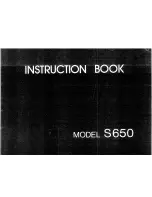
RECORDING SECTION
4–40
• Light areas on the photosensitive drum (“black” image areas)
(1) Here, toner is made to cling on the light areas on the surface of the
photosensitive drum. There also exists a difference between the elec-
trical potential of light areas and the electrical potential of the develop-
ing cylinder. This difference is in a mutual relationship where the
electrical potential of light areas is greater than the electrical potential
of the developing cylinder. Accordingly the light areas on the photo-
sensitive drum try to attract toner. The toner frees itself from the mag-
net to jump to light areas.
(2) Here, excess toner cling to light areas on the surface of the photosensi-
tive drum is removed to improve contract. There also exists a differ-
ence between the electrical potential of light areas and the electrical
potential of the developing cylinder. This difference is in a mutual
relationship where the electrical potential of light areas is smaller than
the electrical potential of the developing cylinder. Accordingly, as the
developing cylinder tries to attract toner, the toner returns to the devel-
oping cylinder. Note, however, that as the difference between the elec-
trical potential of light areas and the electrical potential of the
developing cylinder is slight, this does not mean that all toner cling to
light areas returns.
Fig. 4-50 Function of Toner (light areas)
DC bias
(1)
(2)
+ V
- V
0
t
Light area electrical potential
DC bias
electrical potential
Developing cylinder
electrical potential
(1)
(1)
(2)
Photosensitive
drum
Toner
Developing
cylinder
AC bias
Voltage of light area
(1)
(2)
















































